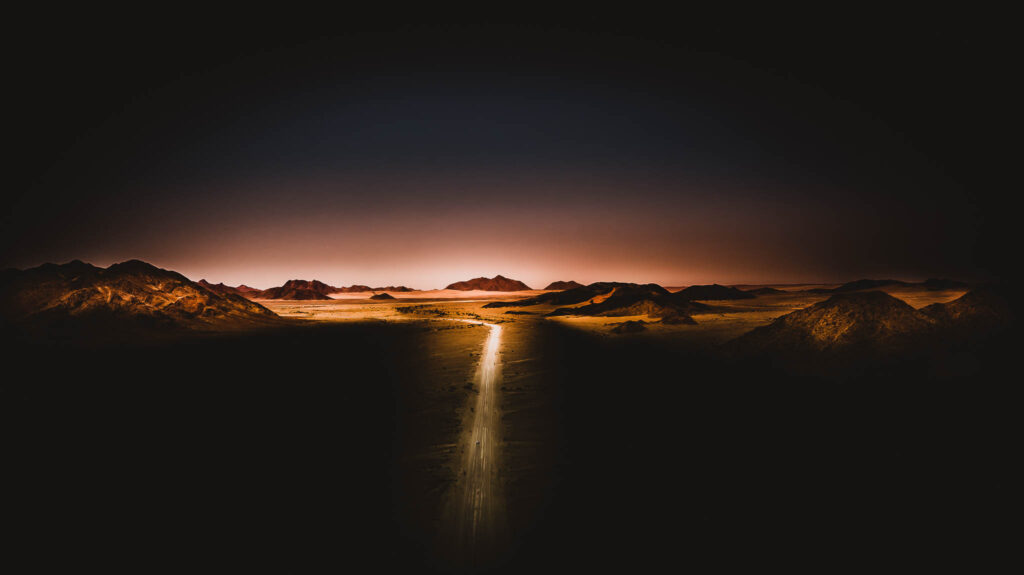Namibia’s terrain also offers an awe-inspiring variety of landscapes: from the dramatic sand dunes of the Namib Desert to the coastal wonders of the Skeleton Coast and the wildlife-rich plains of Etosha National Park. These diverse ecosystems are best explored independently, at your own pace, with the freedom to stop wherever inspiration strikes.

Self-Drive Freedom and Flexibility
On a self-drive safari, you’re the captain of your journey. You have the freedom to choose where and when to stop, explore hidden gems, or simply linger a bit longer at breathtaking viewpoints. Namibia’s well-maintained roads and infrastructure make it an ideal place to embark on a self-drive safari, allowing for a deep, personal connection to its incredible landscapes.
Iconic Routes and Wildlife Encounters
Namibia is home to some of Africa’s most iconic routes. Highlights include the desert landscapes of Sossusvlei, the rugged terrain of Damaraland, and the abundant wildlife of Etosha National Park. Along these routes, you’ll have chances to encounter elephants, rhinos, lions, and various other species—all from the comfort and safety of your rental vehicle. Due to the rough road conditions in Namibia, it is important to have a spare wheel, as many rental cars come with one as standard, and some even offer an additional spare wheel to save time and hassle in case of multiple punctures during your trip.
Planning Your Self-Drive Safari
When planning your self-drive safari in Namibia, selecting the right rental car and company is a crucial first step. With numerous car hire companies available, it’s essential to research and compare options to find the one that best suits your needs. Consider factors such as the type of vehicle, rental duration, and additional services offered. Look for companies with a solid reputation, a diverse fleet of vehicles, and a straightforward rental process. Some popular car hire companies in Namibia include Asco Car Hire, Europcar, and Avis. These companies are known for their reliable service and comprehensive vehicle options, ensuring you have a smooth and enjoyable self-drive safari.
Preparing for Your Trip
Preparation is key to a successful self-drive safari in Namibia. Start by researching the road conditions, weather patterns, and local driving laws to ensure a safe and enjoyable journey. Before setting off, thoroughly check the vehicle’s condition, including spare tyres and any camping equipment if you’re planning to camp. Familiarize yourself with the vehicle’s features, such as the GPS navigation system and off-road driving capabilities. Additionally, consider purchasing a local SIM card or renting a satellite phone to stay connected in case of emergencies. Being well-prepared will help you navigate Namibia’s diverse landscapes with confidence.
Understanding the Terrain and Gravel Road Conditions
Namibia’s road network covers three primary types: paved roads, gravel roads, and sand tracks. Paved roads are found between major cities, but gravel roads dominate rural areas and nature reserves. While generally well-maintained, gravel roads can be tricky to navigate for those unaccustomed to them, especially after heavy rains that may cause washouts and ruts. Sand tracks, particularly in the desert, demand a vehicle with excellent traction control. Having a second spare wheel is crucial due to the challenging road conditions, as it can save time and reduce hassle in case of multiple punctures during a trip.
Weather Considerations
Namibia’s climate varies from arid desert in the south to subtropical in the north. While Namibia is generally dry, the rainy season (January to April) can affect road conditions significantly. Heavy rains can turn gravel roads into slippery tracks, so travelers during this period should be cautious and consider a 4×4 vehicle for added safety.
Long Distances Between Destinations
“Namibia’s roads is vast, with long stretches of road separating many key destinations. The distance between some towns or gas stations can be hundreds of kilometers, so travelers must account for these distances when choosing their vehicle. Having enough fuel and planning stops carefully are key to a stress-free journey.

Driving in Namibia
Understanding and adhering to local driving laws and regulations is essential when driving in Namibia. The country has a relatively low crime rate, but it’s still important to take necessary precautions. In urban areas, the speed limit is 60 km/h, while on sealed roads away from urban areas, the speed limit is 120 km/h. On gravel roads, the speed limit is 100 km/h. Always wear a seatbelt, and ensure all passengers are buckled up. Additionally, be aware of the local traffic laws park regulations, including the requirement to drive on the left-hand side of the road. Familiarizing yourself with these regulations will help ensure a safe and enjoyable self-drive safari.
Essential Factors in Choosing the Right Vehicle
A common question for travelers is whether a 4×4 is necessary for road trip. For paved roads and main routes, a 2WD vehicle can suffice. However, if you plan to explore off-the-beaten-path areas, a 4×4 vehicle is essential for navigating gravel roads, sand dunes, and rugged terrain. In places like Sossusvlei and the Skeleton Coast, 4x4s are indispensable for safe travel.
Fuel Efficiency and Tank Size
Since gas stations are sparsely populated country are scarce in remote areas, choosing a vehicle with a large fuel tank or good fuel efficiency is critical. Larger 4×4 vehicles often consume more fuel, so if you’re covering long distances, consider a fuel-efficient model with an extended tank. Carrying extra fuel is also advisable when traveling off the main routes.
Comfort for Long Drives
Comfort should be a priority when spending hours on the road. Choose a vehicle with air conditioning, comfortable seats, and adequate legroom. An ergonomic seat can make a big difference on gravel roads, where the ride may be bumpier.
Safety Features
Navigating Namibia’s wilderness requires reliable safety features. Look for vehicles with traction control, anti-lock brakes, and ample ground clearance. Additionally, a spare wheel, jack, and basic tool kit are essential in case of a flat on remote roads.
Top Vehicle Choices for Namibia’s Self-Drive Safaris
SUVs like the Toyota Land Cruiser are well-suited for Namibia’s varied terrains. They offer high ground clearance, solid suspension, and 4×4 capabilities, making them perfect for both rugged paths and paved roads. Their spacious interiors provide ample room for gear and comfort during long drives.
Pickup Trucks for Storage and Versatility
Pickup trucks, such as the Ford Ranger, are versatile vehicles for a Namibian safari. With strong off-road capabilities and ample storage in the truck bed, they’re ideal for carrying extra fuel, water, and camping equipment. Pickups are also durable, built to withstand the challenges of rough terrain. Additionally, a tent that can be easily set up on the roof of a pick-up truck offers convenience for road trips, allowing for quick transitions between campsites without the traditional hassles of ground tents.
4×4 Campers for Camping Adventures
For those planning a camping safari, a 4×4 camper offers the best of both worlds: a rugged off-road vehicle with camping amenities like rooftop tents, cooking equipment, and storage for supplies. These campers are perfect for travelers wanting to stay in Namibia’s wilderness and enjoy the flexibility of setting up camp anywhere.
Additional Equipment and Accessories
A reliable GPS and offline map apps are essential in Namibia, where mobile signal can be limited. Consider bringing a physical map as backup, as well as an emergency beacon if you’re traveling in very remote areas.
Emergency Gear and Spare Tyres
When driving in Namibia’s remote regions, carry spare tires, a tire repair kit, recovery gear, and basic tools. In the event of a breakdown, having these items will help you remain self-sufficient until assistance arrives.
Camping Essentials
If you’re opting for a camping safari, pack items like a rooftop tent, camping gas stove top, cooler, and necessary cooking utensils. This gear will make your wilderness experience comfortable and enjoyable.
Costs and Budget Considerations
Rental costs vary depending on the type of vehicle and length of rental. 4×4 vehicles are generally more expensive but essential for certain areas. When renting, prioritize comprehensive insurance that includes coverage for tire and windshield damage, as these are common issues on gravel roads. It is also crucial to choose a reputable car rental company that offers comprehensive insurance coverage.
Fuel Costs
Fuel can be a significant cost on long-distance journeys, particularly for 4×4 vehicles. It’s worth calculating estimated distances and fuel prices to create an accurate budget. Fuel prices are generally lower in urban areas, so consider filling up at fuel stations before heading into rural or remote locations.
Additional Fees and Permits
Expect fees for entering certain national parks, camping permits, and potential road tolls on certain routes. Budgeting for these fees in advance helps prevent unexpected expenses.
Tips for a Successful Self-Drive Safari in Namibia
Vehicle availability can be limited, especially in peak seasons. Booking in advance ensures you get the vehicle that best suits your needs and secures essential insurance coverage. Planning also allows you to select campgrounds or lodges along your route.
Driving Tips and Safety Precautions
Adhere to speed limits, especially on gravel roads where the risk of skidding is higher. Keep a safe distance from wildlife that may unexpectedly cross the road. Avoid driving at night due to the low visibility and high likelihood of encountering nocturnal animals.
Know Your Vehicle
Before setting out, familiarize yourself with the basic operations of your vehicle, such as changing a tire and checking oil levels. This knowledge will save time and reduce stress if minor issues arise on the road.
Packing Essentials for a Self-Drive Safari
Bring enough water, sun protection (hats, sunscreen), and a well-stocked first-aid kit. Snacks, flashlights, and extra blankets can also be handy, especially if you’re venturing into remote areas. Don’t forget essential documents, such as your driver’s license, passport, and vehicle rental agreement, as they’ll be required at checkpoints and during routine stops.
Conclusion
Choosing the right vehicle for your Namibian self-drive safari is the first step in ensuring a safe, enjoyable, and memorable experience. With the right preparation, vehicle choice, and awareness of local conditions, you’ll be ready to embark on an incredible journey through Namibia’s breathtaking landscapes. For more travel tips or to get started on planning your adventure, explore our Namibia self drive tour travel resources or reach out to us for guidance.


